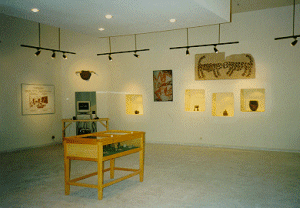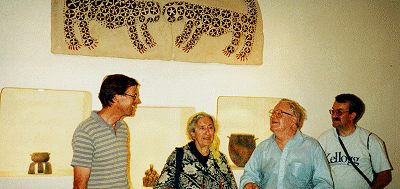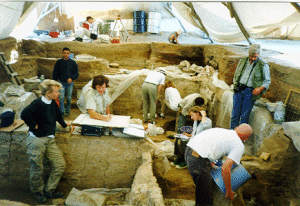INTRODUCTION
Work this year began on 15 July and continued for two months. The team had over 90 people coming from a wide range of countries to join 35 local Turkish workers and 15 Turkish students, 4 from Selcuk University in Konya. The team included members from the United States, Britain, Germany, Yugoslavia, Sweden, Denmark, Israel and South Africa.

Figure 2: Inside the new Visitor Centre. |
With the aid of sponsorship, we have this year added living accommodation and KoçBank has added a Visitor Centre (Çatalhöyük Evi) to the dig house at the site. The dig house now contains three stores, 5 laboratories, and accommodation and eating facilities. The Visitor Centre has been partially provided with displays this year (Figure 2); the displays will be completed in 1999. The work on the Visitor Centre is being organised by Orrin Shane with a team from the Science Museum of Minnesota and Ida Ajans from Istanbul. The Visitor Centre, together with a new booklet about the site, will enable visitors to have more enjoyable and better informed trips to the site. In addition, Don Pohlman from the Science Museum Minnesota has been successful in obtaining a very large grant from NSF to develop their educational web site about the project (http://www.smm.org/catal/), and to produce a related exhibit at the Science Museum. |
The excavations this year have made some exciting new discoveries about the 9000 year old site of Çatalhöyük. Excavations continued on the main East mound, and work has also started on the later West mound which is Chalcolithic (Copper Age) in date. There may be a small gap between the occupation of the two mounds.
This year also revealed renewed interest in the site from the media. In addition to the press day organised by out main sponsors, we had visits from no less than 3 film crews and several journalists writing for a variety of publications including Science (see issue 5393, 20. Nov. 1998) and Discover Magazine. Press day itself was a memorable occasion as usual, especially as visitors outnumbered excavators. In the evening a great feast with live music was held in the courtyard, and the footage which appeared on the television news in the next few days appear to have concentrated on the dancing that took place that evening.
We were also very pleased that James and Arlette Mellart paid another visit to the site together with some of the Friends of Çatalhöyük from Istanbul. This again inspired new interesting discussions concerning the interpretation and understanding of the site. We continue to be enormously indebted to James Mellaart and his family for their support and interest. |

Figure 3: The Mellaarts inspect the new visitor centre. From left: Ian Hodder, Arlette Mellaart, James Mellaart and Alan Mellaart |
A major problem affecting the site is the dropping water table in the area. Intensive water management and irrigation around the site have led to a lowering water table. This is causing damage to the site. We know that the lower, unexcavated, parts of the site were wet and may still have well-preserved organic remains (such as wood, wooden artifacts, baskets) and unfired clay tablets. These are destroyed as the deposits dry out. It would be a tragedy to lose this information about the origins of Çatalhöyük, and so we are planning an extended 6 to 8 month long season of excavations in 1999, starting in April with the goal of digging down to the base of the mound and the earliest deposits. Although it was not possible to finance this through a loan from the World Bank to Turkey, we are now attempting to raise the required finance from sponsorship and grants.
The World Bank has, however, suggested an ambitious scheme for enhancing the public presentation of the site, including a new road from Çumra, walkways at the site and a state-of-the-art museum. Three Turkish architects have suggested exciting concept designs for the museum, and it is hoped to move ahead on this project in the coming year. The project is very indebted to the World Bank team for their support of this scheme and for their help in raising funds for the long season in 1999.
The project was very sad to hear of the tragic death of Maria Mangafa in July 1998. She worked on the site in 1996 with the Greek team as an Archaeobotanist. She was a good friend of the project and is sorely missed. It is planned to dedicate a volume published by the project to her.
We also regret the departure in 1998 of Amanda Cox whose energy and gracious efficiency launched the project in its early years. We miss her and wish her well in her chosen career. In the latter part of the year the administration has been ably assisted by Josephine Stubbs.

Figure 4: A busy day in the North Area, Building 5